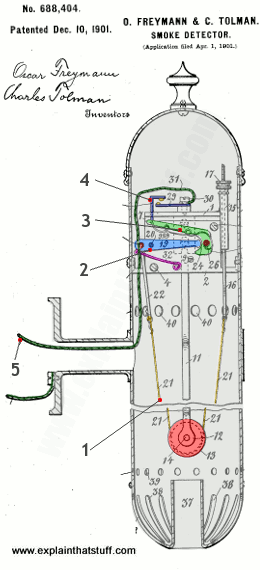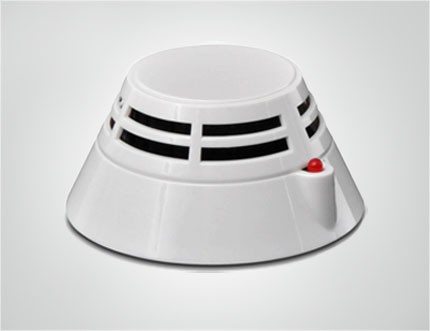Who invented smoke detectors?
Good question! Search online and you´ll quickly find out that fire alarms were invented by US physicist and mathematician Francis Robbins Upton in 1890, while the first smoke detector was invented by George Andrew Darby in England in 1902. A more detailed search will tell you both of these "facts" are wrong.
According to the US Patent and Trademark Office database, Francis Upton and his partner Fernando Dibble filed US Patent 436,961: Portable Electric Fire Alarm on March 24, 1890, and the patent was granted on September 23 the same year. But that wasn´t the first fire alarm, because the USPTO also has on record US Patent 344,673: Automatic fire alarm and extinguisher by William Neracher of Cleveland, Ohio, filed on September 8, 1885 and patented on June 29, 1886—several years earlier than Upton and Dibble´s. Neracher´s alarm is entirely mechanical and works quite like a modern fire sprinkler.
The earliest smoke detector I can find on the US Patent and Trademark Office database is this one, patented by Oscar Freymann and Charles Tolman of Brooklyn, New York City, in December 1901 (and there might be even earlier ones). Surprisingly, for the early 20th century, it´s an electric detector, but it doesn´t use a photocell or ionization (those technologies are much more recent).
Early smoke detector invented by Freymann and Tolman in 1901.
In Freymann and Tolman´s invention, the detecting device is a braided thread of silk, horsehair, or similar, which is boiled in soda for about 20 minutes, then dried and stretched. For reasons the inventors were unable to discover, fibers treated in this way worked as a very effective smoke detector: in the presence of smoke, they loosened and stretched; when the smoke disappeared, they tightened up again.
What´s inside the detector?

Once Freymann and Tolman had discovered their fiber, it was relatively simple to build a part-electrical, part-mechanical smoke detector around it:
A length of the magic fiber (yellow) is stretched around a wheel (red) inside a metal container (gray) with holes at the bottom through which smoke can enter.
The fiber is attached to a pivoting lever (light blue), held in place by a spring (purple).
The blue lever holds another pivoting lever (green) in place.
The green lever supports an electrical contact (dark blue) and holds it well above a second identical contact.
The two contacts connect to a battery-powered bell or other electrical alarm circuit (not shown).
How does it work?
When smoke enters the chamber through the holes at the bottom, it makes the fiber (1) contract. That makes the light blue lever (2), tilt downward, so the green lever (3) also tilts down, allowing the upper electrical contact (4) to touch the lower one. This completes the circuit and triggers the alarm. Ingenious!
Get a smoke detector... check a smoke detector!

If you´ve not got a smoke detector in your home, why not? They cost just a few pounds/dollars and could save your life. Get one at once or, better still, get several and put them up in key places around your home. If you have got smoke detectors, make sure you check they work once a week (are the batteries still good?) and vacuum the dust out of them regularly. Get into the habit of checking detectors whenever you clean the room you´re in. A defective smoke detector is as bad as—or worse than—no detector at all, because it gives you a false sense of security.

